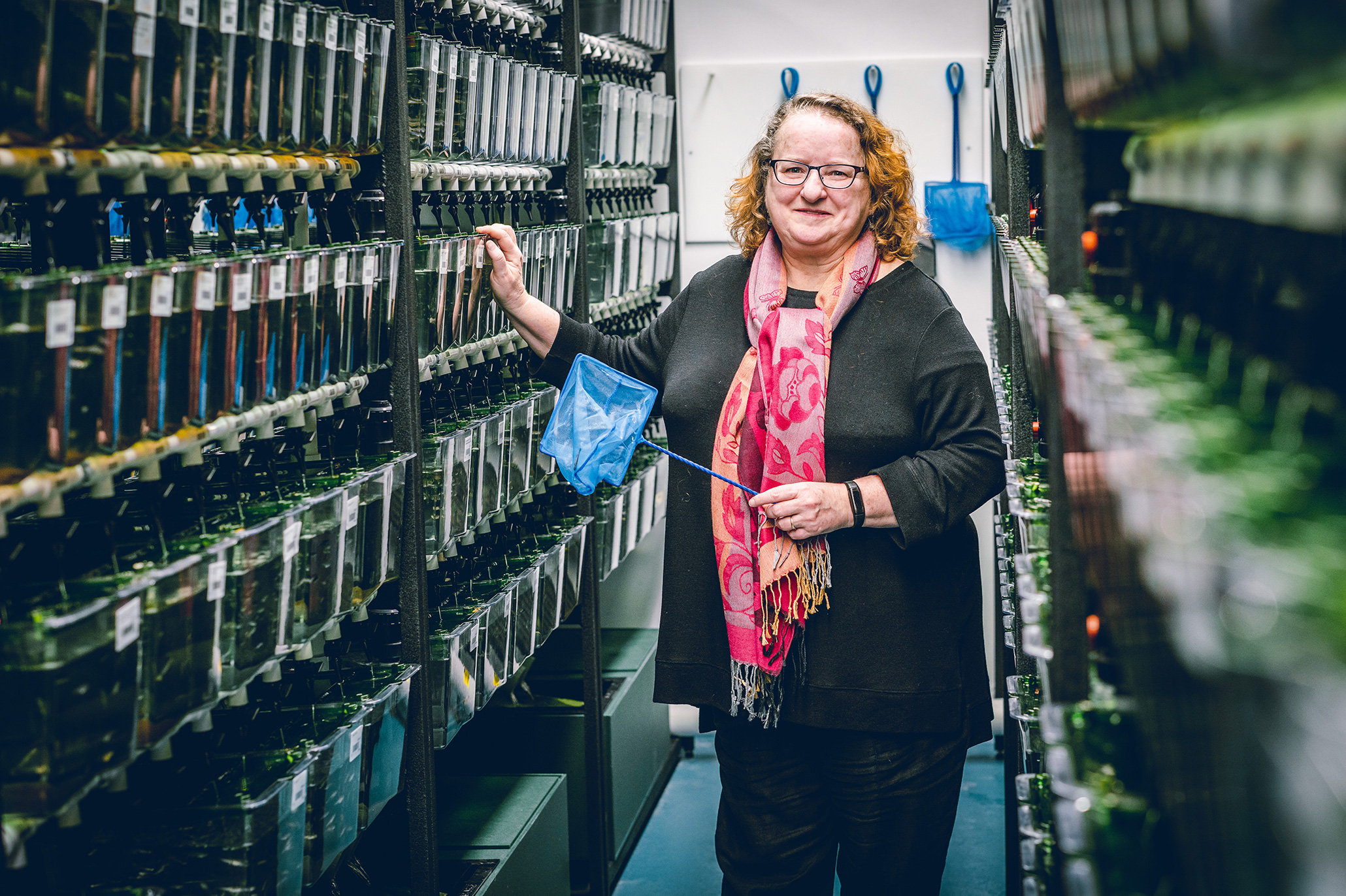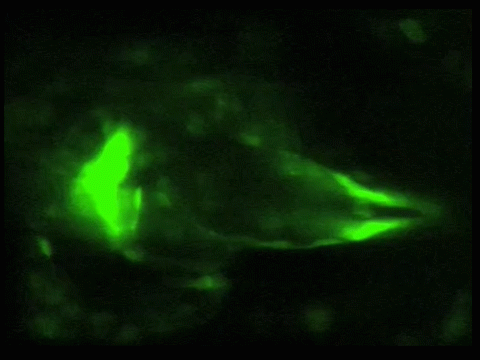All photos and video by Kurt Wehde.

Looking through the eye piece of a special, high-powered microscope at the beating (two-chambered) heart of a zebrafish larvae—illuminated by bright green cells—gives an instant appreciation for its appeal in medical studies.

“Isn’t that amazing?” asks Marnie Halpern, PhD, chair and professor of the Department of Molecular and Systems Biology at Dartmouth’s Geisel School of Medicine. Halpern, who heads up the medical school’s impressive new zebrafish research facility, is world-renowned for her contributions to developmental genetics and the underpinnings of neural development.
“The zebrafish is a very powerful genetic model,” she says. “The embryos are transparent at early developmental stages and because of that clarity, you can watch all of the tissues and organs developing right before your eyes.”
As Halpern gives you a tour of the facility, located in Geisel’s Vail research building, she stops to highlight one of the lab’s injection stations. Here, lab team members use advanced gene editing techniques that include inserting different-colored fluorescent proteins into the fish embryos.
This allows them to label and track how a specific change or mutation made to the fish’s genome—known as a transgenic line—affects the development of individual cells and how they differentiate into tissues. Since the zebrafish’s cell physiology is similar to that of humans, it’s a valuable model for studying a myriad of diseases.
“My lab is particularly interested in the developing nervous system, the brain and spinal cord, and in our most recent work we’ve been studying left-right differences in the brain,” explains Halpern. “We have the unique ability to alter the natural asymmetry that occurs—to make fish that are left-left or right-right brained—and see how that affects behavior.”
She and her team have found, for example, that fish with symmetric brains actually show features of being more fearful or anxious in a number of behavioral tests. In other studies, they’ve shown that a very small left-right difference in the number and types of neurons can influence how the neighboring part of the brain develops.
A stop at the workstation of Emma Spikol, a graduate student in the Halpern Lab, helps bring this work to light. “These are a subset of neurons in the brain that we think are involved in responding to negative stimuli,” she explains, pointing to the brightly colored strands extending across her monitor. “The confocal microscope has lasers that excite the fluorescent proteins and allow us to capture these images and trace exactly where the neurons connect up in the brain.”
Such findings, says Halpern, may enhance understanding of the cellular basis of neurological disorders—from schizophrenia to depression syndromes to addiction—and how very small changes that occur early on can have far-reaching consequences later in life.
In the main fish rooms, where nearly 3,000 tanks already house thousands of adult and baby zebrafish, you immediately notice the change in temperature. “These are tropical fish, indigenous to southeast Asia, so we keep the rooms at about 80 degrees,” says Halpern, who shows you a few examples of mutations in adults—phenotypes that can change their normally striped appearance to having no pigment at all (called Casper) or dark spots (called leopard).
Halpern notes the attributes that make the species one of the most popular models in medical research. “Zebrafish grow quickly, from a fertilized egg to a mature adult in less than three months,” she says. “One female can lay hundreds of eggs each week. And they’re small, growing only to about one and a half inches long, which means you can have lots of them—in genetics, it’s all about numbers.”
Halpern and her lab team use barcoded labels affixed to each tank, which can be scanned and connect to a database. This helps them keep track of the location as well as the age, lineage, and specific characteristics of the fish, both at Vail and at the program’s smaller sister facility in the Williamson Translational Research Building on Geisel’s campus at Dartmouth-Hitchcock Medical Center.
The latter facility is headed by Steven Leach, MD, a highly respected physician scientist known for his work on pancreatic cancer, who collaborated on zebrafish research with Halpern while they were both at Johns Hopkins University in Baltimore, and who now serves as director of the Norris Cotton Cancer Center.
“Together, we’re known as DartFish,” she says, noting that with the addition of Dionna Kasper, PhD, the new faculty member she’s recruited from Yale who will be arriving this summer, the program will soon include over 20 people.
The DartFish program’s highly organized tracking system proved invaluable last spring when Halpern, with help from her husband Charlie Ippolito, moved hundreds of tanks of fish—transported in Tupperware containers inside Igloo coolers—and all of her lab equipment from Baltimore.
“It was a ton of work, made more stressful by the pandemic,” she recalls. “But the whole transition went smoothly, thanks to Steve’s generosity—he let us keep our fish in his facility while this one was being built, and also shared some special microscopy equipment which has been vital to our studies.

“And I would be remiss if I didn’t mention how instrumental people like Dave Harris and John Rader (both recently retired from Geisel’s Facilities Office), Jamie Clark (Engelberth Construction), and Eric Stone (Aquatic Enterprises) were in addressing any issues that came up and getting our whole program up and running successfully.”
During a visit to the Williamson Building fish facility, Leach describes some of the key advantages of using zebrafish in his research. “It turns out that the same mutations that cause pancreatic cancer in humans cause pancreatic cancer in zebrafish,” he explains.
Zebrafish fertilize their eggs externally, giving researchers immediate access to single-cell embryos and the ability to watch developmental events related to cancer as they unfold. “Also, it’s fast, easy, and inexpensive to create transgenic lines of zebrafish, so we can literally examine the effect of hundreds of human pancreatic cancer mutations in zebrafish, versus only being able to test about a dozen in mice. That’s really helped to ramp up the pace of our research.”

In one of their major breakthroughs using the zebrafish model, Leach and his colleagues were able to determine how pancreatic cancer adult cells revert back to an embryonic-like phenotype through activation of the “Notch” signaling pathway. Based on this work, Notch pathway inhibitors are now being evaluated in clinical trials as a potential new therapy for pancreatic cancer.
When asked how he sees the zebrafish model impacting Dartmouth’s research enterprise, Leach says, “I think it’s a way to catalyze research across all of Dartmouth and Dartmouth-Hitchcock, bringing together investigators from different areas of expertise. That’s one of the strengths of Dartmouth, is that we’re right-sized for interaction across disciplines.”
One such investigator is Britton Goodale, PhD, a research scientist with expertise in toxicology, molecular biology, and bioinformatics who directs the DartFish facility in the Williamson Building. “We’ve been collaborating on some studies with Margaret Karagas (PhD) and Brock Christensen (PhD) in (the department of) epidemiology, looking at the effects of early-life arsenic exposure on the developing immune system,” she says.
A growing amount of data, through Karagas’s New Hampshire Birth Cohort Study and the research of other investigators, has shown that early exposure to arsenic, from sources like contaminated well water, is associated with a host of health problems that may lead to diseases such as bladder cancer later in life. “But we really don’t have a good understanding of how that happens,” says Goodale. “That’s where we think the zebrafish models can really help us.
“Dartmouth has a wonderful environment for collaboration,” she adds. “It’s been great to have the opportunity to have close connections with scientists from different departments, and to do work that we hope can have a real impact on the health of people in our communities.”




